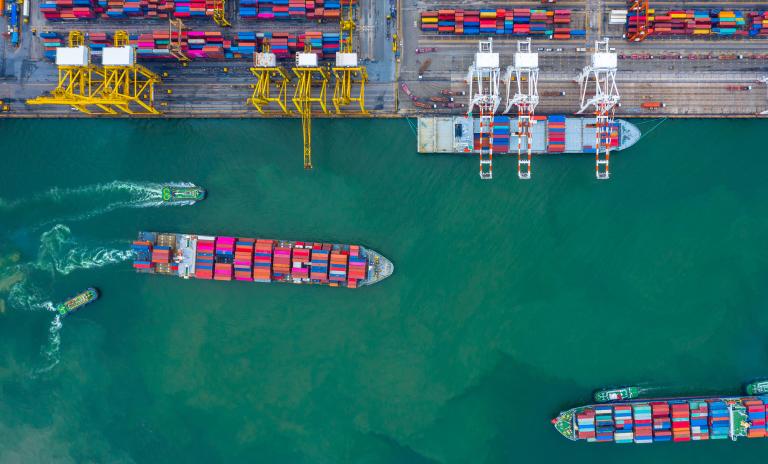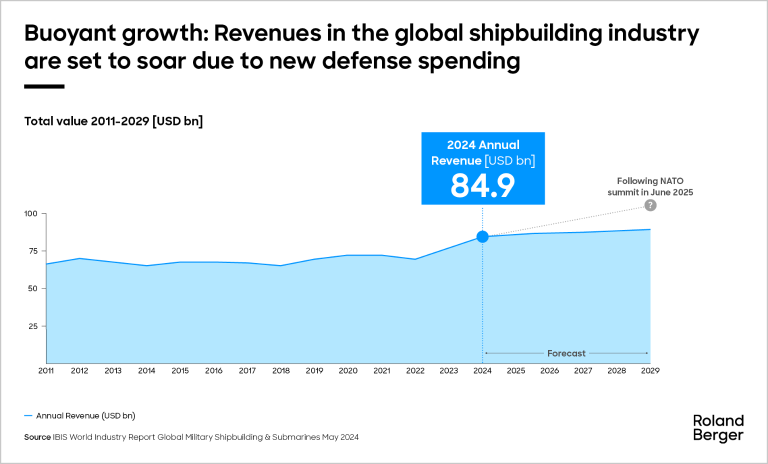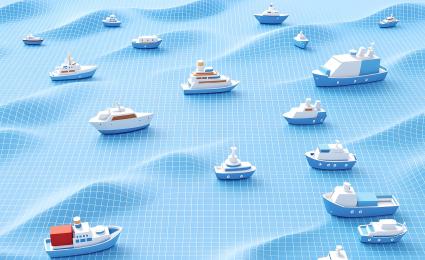Explore how hydrogen can drive decarbonization in the maritime sector. Discover the Middle East's potential as a clean bunker hub for sustainable shipping.


Smooth sailing in shipbuilding
Boosting resilience across the sector
The global shipbuilding industry is in choppy waters. The COVID-19 pandemic disrupted operations and strained the traditional business models that many shipbuilders rely on. In the aftermath, high inflation further compounded these difficulties, squeezing profit margins and increasing the urgency for more effective cost management. Today, geopolitical uncertainties, such as the threat of rising US tariffs and retaliatory measures, underscore the need for the industry to reassess strategies that have served it for decades.

So, what should this re-evaluation focus on? In this article, we examine the current state of the shipbuilding industry, explore the key challenges it faces, and highlight why resilience is essential for long-term success. We also present six resilience levers that will enable shipbuilders to maintain high performance and competitiveness, even in turbulent times – with Roland Berger offering tailored tools to support these efforts.
Industry status and outlook: Trade, aging fleets and uncertainty driving growth
Following the disruptions of recent years, the shipbuilding industry has regained a measure of stability. Shipbuilders are currently benefiting from a strong market outlook, with steady growth projected over the next decade. For example, the commercial shipbuilding market is expected to grow at a compound annual growth rate of 2–3% through 2030.
This growth is driven by several factors. Long-term global trade forecasts, aging fleets that require replacement, and stricter environmental regulations – such as those introduced by the International Maritime Organization (IMO) – are all creating sustained demand. By 2035, we anticipate the addition of 20,000 new ships, totaling more than 2,000 gigatons, to the global fleet.
Geopolitical instability is also contributing to growth, particularly in the defense sector. Rising risks of conflict have led to increased defense budgets worldwide. NATO, for instance, has set new annual defense spending targets of 5% of national GDPs, which will necessitate significant investments in related equipment and infrastructure. This presents opportunities for companies involved in both military and commercial shipbuilding which could strive for dual-use.
"Shipbuilding resilience demands more than endurance—it requires proactive supply chain planning to eliminate weak links before they impact performance."
Several countries are already advancing plans to modernize and expand their naval capacities. Germany, Norway, and Canada are investing in new submarine fleets, while Australia and the United States are working to significantly enlarge their overall naval capabilities. These plans often include the addition of uncrewed and autonomous underwater and surface vessels. The US Navy, for example, aims to build a fleet of 500 vessels, comprising 350 crewed and 150 uncrewed ships.
Regional expansion to meet growing demand
To accommodate market growth, regional shipbuilding capacities are expanding. In Saudi Arabia, the International Maritime Industries (IMI) shipyard – the largest in the Middle East, with a 12-million-square-meter facility capable of producing 40 newbuild vessels and servicing 260 maritime products annually – is scaling up production. In Morocco, the National Ports Agency has issued tenders for Africa’s largest shipyard, aiming to capture demand overflow from saturated European shipyards and serve African ships heading to Europe.
Meanwhile, the United States is bolstering its commercial shipbuilding sector through legislative and financial support. A $5 billion investment, part of a comprehensive shipbuilding bill, is being funneled into the industry, with additional partnerships formed with South Korean shipbuilders Hanwha and Hyundai Heavy Industries.
The forecasted growth and capacity expansion plans present exciting opportunities for shipbuilding companies to capture new markets and scale their operations. However, these opportunities are not without risk. The industry must navigate a complex environment shaped by economic pressures, geopolitical tensions, and shifting regulatory landscapes.
In the face of these challenges, resilience will be the key differentiator for shipbuilding leaders. By adopting forward-looking strategies and leveraging innovative tools, the sector can chart a course toward sustainable growth and long-term success.
The five major challenges facing shipbuilders
In light of the factors outlined above, we have identified five key challenges currently facing the shipbuilding industry:
- Geopolitical instability
- Financial performance pressure
- Growing cost of supply
- Overstretched supply chains
- Delivery capacity limitations
Geopolitical instability
The ongoing wars in Ukraine and the Middle East, coupled with the potential for a China-Taiwan crisis, underscore the tectonic shifts in the geopolitical landscape in recent years. While the degree of exposure to these risks varies across companies, the overall impact is felt sector-wide. Shipping routes are increasingly at risk, and energy prices remain volatile, creating an environment of persistent uncertainty.
Strategically, shipbuilders must ask themselves: What is required to remain competitive in this evolving international order? Those who can adapt to the new geopolitical realities will be better positioned to navigate the challenges ahead.
Financial performance pressures
Securing financial performance has never been more critical. Shipbuilders need to maintain profitability to reinvest in transformative technologies such as alternative propulsion systems and autonomous vessel products. Innovation is key to ensuring long-term competitiveness.
Additionally, maintaining financial flexibility is essential to weather unexpected shocks, such as sudden order slowdowns or external disruptions. Without addressing these financial pressures, shipbuilders could face existential risks to their operations.
Growing cost of supply
The cost of materials and manufacturing remains volatile and is likely to trend upward. Shipbuilders must contend with rising logistics costs, tariff impacts, raw material price spikes, and increasing labor costs driven by skilled workforce shortages—particularly in Europe and the US.
Although demand in the shipbuilding industry is currently robust, buyers remain highly cost-sensitive. To stay competitive, shipbuilders must focus on identifying synergies and improving operational efficiencies.
Overstretched supply chains
For decades, global supply chains have been the cornerstone of shipbuilding operations. However, recurring disruptions have made this model increasingly fragile. The reliance on best-cost suppliers in regions such as China or Eastern Europe is now being reconsidered in favor of more resilient, localized supply chains.
This shift is particularly urgent given the additional demand from the military sector, which risks overstretching the supply of critical components. In some cases, such as the US, commercial shipbuilding supply chains may need to be re-established almost from scratch. Strengthening supply chain capabilities is no longer optional—it is imperative.
Delivery capacity limitations
Aging populations in Europe and Asia are creating workforce shortages that directly impact shipbuilders’ ability to maintain or expand manufacturing capacities. For example, South Korea's shipbuilding industry has only been able to increase its workforce by attracting approximately 2,500 international workers.
The situation is further complicated by regional competition for skilled labor, as most shipyards are concentrated in specific areas, such as the German North and Baltic Sea coasts. This drives up salaries and intensifies the challenge of recruiting and retaining talent. To address this, workforce planning must be treated as a strategic priority rather than an ad-hoc response.
Resilience levers: How to build strength and reap the opportunities
The challenges outlined above demand immediate attention. Shipbuilders must assess their exposure to these challenges and take proactive steps to mitigate them. More importantly, to capitalize on the growth opportunities in the industry, they must build resilience. This involves focusing on what can be controlled to avoid being thrown off course.
To guide this effort, we have identified six resilience levers that will help shipbuilders secure both short-term performance and long-term competitiveness.
"To stay ahead in shipbuilding, companies must rediscover design-to-cost and rethink material cost strategies in the face of mounting financial pressure."
Strengthen supply chain planning
Geopolitical instability calls for a thorough review of shipbuilders’ planning capabilities. We are seeing a trend away from globalized and interdependent value chains toward more regionalized/localized and decoupled value chains.
Geopolitical instability necessitates a thorough review of supply chain planning capabilities. The trend toward more localized and decoupled value chains is accelerating, requiring shipbuilders to rethink their traditional approaches.
A supply chain planning maturity analysis can help identify weak links and define measures to address them. For example, implementing a robust planning system can improve forecast accuracy by up to 15%. Additionally, enforcing a Sales and Operations Planning (S&OP) process can enhance internal alignment, prevent planning errors, and strengthen collaboration with supply chain partners.
Revamp direct material cost reduction
With material costs accounting for up to 70% of revenue, reducing these costs is a critical component of resilience. Recent crises have deprioritized cost-cutting initiatives in favor of securing volumes, but this must change.
By leveraging tools such as cost and value analysis and software-based cost calculations, shipbuilders can achieve material cost reductions of 10–15% within a year. Recent examples from the European shipbuilding industry demonstrate the effectiveness of these measures.
Rediscover design-to-cost
In new projects, 80–90% of costs are determined during the initial design phase. However, shipbuilders often rely on legacy designs or supplier-provided solutions. Rediscovering design-to-cost methods, such as should-cost analysis and collaborative cost breakdown approaches, can reduce costs by 7–34% depending on the component.
Even in the naval sector, where sourcing restrictions limit supplier options, significant cost-saving potential exists and can be realized with proven procurement cost-out programs. This is even more important as naval products are even more CAPEX intensive than commercial products.
Refocus on customer centricity
Customer centricity will be a critical differentiator in the years ahead. Shipbuilders, from large commercial vessels to yachts, must understand their customers’ purchasing criteria, preferences, and future needs across the entire lifecycle—from initial purchase to maintenance and repurchase.
Effective management of omni-channel sales strategies (e.g., direct sales, digital platforms, and distribution networks) will be key to achieving customer satisfaction and loyalty. This approach also helps optimize cost-to-serve, ensuring competitiveness in a high-CAPEX industry where contracts are often awarded for entire fleets rather than individual ships.
Enhance your digital and AI potential
A robust ERP system forms the foundation of any resilience strategy, enabling shipbuilders to make data-driven decisions. For those without such systems in place, establishing this IT backbone should be a priority.
In parallel, shipbuilders should explore productivity-enhancing AI tools. For example, AI-driven supplier quote comparisons can eliminate days of manual work, while document analyzers can save 70–80% of time spent on procurement tasks.
"The future of shipbuilding hinges on strategic workforce management—replenishing skills and capacities to keep delivery timelines afloat."
Develop a strategic workforce management plan
To address workforce shortages, shipbuilders need a comprehensive workforce management plan. This includes identifying skills gaps, forecasting future workforce needs, and accounting for the impact of automation and AI on labor requirements.
Regions with rapidly expanding shipbuilding capacities, such as the US, South Korea and parts of Europe, must act quickly to ramp up recruitment and training efforts. Competition for talent is fierce, and shipbuilders must position themselves as employers of choice to secure the skilled workforce they need.
Next steps: How to make resilience work for you
Opportunity knocks for resilient shipbuilders. While geopolitical and supply chain risks in the industry demand heightened flexibility and potential mitigation, strong and proactive players that move quickly to build up resilience will be well-placed to reap the benefits of predicted growth. In short, they need to be able to control what they can control to balance their CAPEX-heavy, long-term industry with the current range of risks. Our resilience levers will ensure they can do exactly that.
Roland Berger has extensive experience in the shipbuilding industry. Combined with our toolbox of effective, resilience-building products, we enable clients to mitigate industry risks and harness growth opportunities. The results are simple – resilient companies with heightened performance and competitiveness that are fit for a successful future. For more information, please get in touch with one of our experts.

















